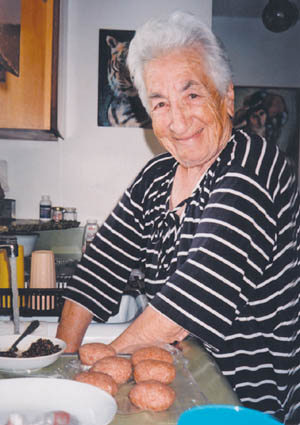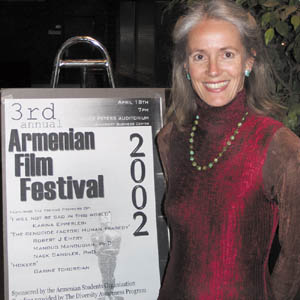Arpik Paraghamian
Staff Writer
Over 125 Armenian students and members of the community had the opportunity to see four films make their Fresno debuts at the Third Annual Armenian Film Festival on Thursday, April 18, in the Alice Peters Auditorium.
For the past three years, the Armenian Students Organization and the Armenian Studies Program, with funding from the University Student Union Diversity Awareness Program, have hosted the film festival. The film festival has become known for featuring the films of a new generation of Armenian writers, producers and directors.
“This event is basically for Armenian directors or producers to come and show their films,” said Talar Atarian, secretary of the ASO and organizer of the Film Festival. Atarian said the film festival is a great way to get the community together and is a place where filmmakers can present themselves and their work. “These aren’t major films that you would see in big theaters, which is why we need these types of events,” Atarian said.
“The purpose of the film festival is to promote films with an Armenian theme. This year’s theme happens to be the genocide,” said Barlow Der Mugrdechian, lecturer in the Armenian Studies Program.
The first film shown was part one of a four part series, “The Genocide Factor: The Human Tragedy,” which explores the history of genocide and how it effects various nationalities throughout the world, As the audience watched the first episode in the series, “The Beginning to the Armenian Genocide,” written by Manoug Manougian, Ph.D. and Jack Sandler, Ph.D. and produced and directed by Robert J. Emery, they gasped or turned away shaking their heads at the horrors that were allowed to take place. The film takes a look at the definition of genocide and the factors that drive people to it.
“The Genocide Factor,” which took three years to make, will be aired in its entirety on public television stations nationwide in May.
The second film touched upon the Armenian Genocide in a different way. “I Will Not Be Sad In This World” a 56-minute documentary by award winning producer/director, Karina Epperlein of Berkeley, followed a 94 year-old survivor throughout her daily routine. The subject, Zaroohe Najarian lost everything at the hands of Turkish soldiers as part of the Armenian Genocide during World War I. As one of the oldest living survivors of the Armenian Genocide, Najarian grew up in an orphanage in Beirut, Lebanon before immigrating to America, where she divorced her husband of an arranged marriage and created a second family with the man she really loved. For fifty years Najarian supported herself as a seamstress. The documentary shows Najarian being as candid as an old woman can be. The audience was delighted to see her vacuuming her living room, cooking authentic Armenian dishes, singing to her great grandson and gardening as well.
Epperlein was present at the Film Festival and after her film screened, she discussed why she made the movie and how it came about.

As an independent filmmaker, Epperlein chooses the subjects of her films very carefully. She found Najarian through a story written about her by her son, Peter Najarian. As she read the story, Epperlein saw a film taking shape in her head. “I didn’t yet have the courage to start a new film. I was so much in debt from my last project,” said Epperlein. She wouldn’t meet Najarian for another year, but when she did she was fascinated. “She was so open to me. She just let me into her life,” said Epperlein. For her documentary, Epperlein took a different approach. “I didn’t come in like a regular filmmaker who just goes and asks questions. I really made a friendship with her. For four years I came and visited and we became friends,” Epperlein said. Epperlein was amazed to see Najarian so vibrant after having lived through such difficult times. “There’s a whole century she has lived, with all of the tragedies and hardships and also the joys of her life. And here she was, not bitter in her old age. So vibrant and vital that I wanted to be around her and I wanted to share her with the world,” said Epperlein.
Epperlein grew up in post-war Germany and studied Armenian history and culture for five years in order to make her latest film. She said making the film was a wonderful way of accomplishing her goal of capturing Najarian’s spirit and giving it onto the world.

Epperlein has come to find that Armenian audiences that see the film have totally embraced it because they can see themselves in it as well as someone who is so similar to their own grandmother. “I tried to make the film universal so that everybody could take something from it and so non-Armenians could also learn about the genocide,” said Epperlein. Today Zaroohe Najarian lives in a nursing home.
The last two short films shown were creative in a modern sense. “Hokees” and “Girl From Moush” were written and directed by self-taught filmmaker and photographer, Garine Torossian. Born in Beirut, she moved to Canada in 1979. In “Hokees,” which stars Arsinee Khanjian, the ultimate Armenian taboo is committed: an Armenian woman, Anahid, falls in love with a Turkish man. Pregnant with her lover’s child, Anahid finds herself haunted by her past as her great-grandmother, who was murdered along with her unborn child in the Armenian Genocide, returns to reclaim what was lost. “Girl from Moush” was a lighter and more personal short (5 minute) clip that documented Torossian herself through an emotional and psychological geography. The film was filled with images of Armenian cultural treasures.
 Hye Sharzhoom Armenian Action
Hye Sharzhoom Armenian Action